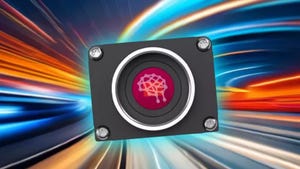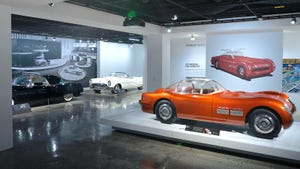February 23, 2011

Leveragingadvances in the PC world, human machine interfaces (HMIs) are experiencing botha technology boost and a significant change in their strategic role. Backed byfast Intel Atom processors, inexpensive memory, larger screens and morepowerful operating systems, HMIs are becoming a vital linkfor communication between the factory and enterprise business systems.
Driven by these new technologies, SCADA and data loggingfunctions are landing on the HMI, and there is a potential convergencewith routers and switches. In addition, mobile devices are openingnew HMI pathways for visualization using remote connectivity solutions. Thesechanges are likely just the beginning of a shift that is moving HMIs toward thecenter of machine design as panels increasingly occupy a central, pivotalposition in future design innovations.
Operator Interfaces Become a Communication Nexus_B |
HMI is the Crossroads
"From the machine design point of view, we're going to seethe HMI more and more as the nexus for communication," says Mike Granby,president of Red LionControls. "It's the point where all the devices on the machines cometogether, at least on a strategic basis, to share information and also to passthat information upwards to high-level systems."
The HMI is not only the nexus, but also serves as the gateway that passes that information to themanagement system in the factory. Obviously, the role of the HMI has changeddramatically from a push-button replacement in years past to an advancedvisualization tool performing protocol conversions and connecting all of theitems in a panel. Data logging has become an important function, and is being used torecord everything going on in the machine including faults, performance tracking and scheduled maintenance.
"I would say that the dual Ethernet HMI we have beenintroducing on HMIs has been our most significant new product," says Granby. a euro S"Modems have also been verysignificant, and Crimson 3, our new software package, makes it a lot easier toget to three key features: data logging, protocol conversion and Web servers."
He says dual Ethernet is exciting technology becauseusers typically have one network on the machine with fixed IP addresses doingall of the control functions. If you want to connect this machine to thecustomer's IP infrastructure, but only want one IP address and have itprotected, you can use a firewall box. a euro ..."But if you want an industrialized one, it's not goingto be cheap and it's another point of configuration," Granby says.
Mainstream IT Inside
"The great thing about HMI if it'sPC-based, is that it can follow what's happening in the consumer, IT andmainstream computing worlds," says John Kowal of B&RIndustrial Automation. "We have certainly seen the Atom processor provide abig boon. It's designed for mobile computing, so it runs very cool, allowssuppliers to provide completely sealed HMIs, and the prices are great. We havehad some units that have 40 percent less cost because of the Atom processor."
Operator Interfaces Become a Communication Nexus_D |
Kowal says we are going to see a convergence of consumerand industrial software in the HMI space over the next couple years.Convergence usually takes longer in the industrial market, but he sees ithappening with a lot more Windows applications on the HMI for safety, security,OEE (overall equipment effectiveness) and MES (manufacturing execution systems)applications.
"Everything affects everything else. I think we are goingto find that the same types of data points that you're looking at for onereason, you should be looking at for multiple reasons and the applicationsshouldn't be siloed," Kowal says. "We have been talking about putting animationon HMI for training and walking through maintenance procedures so that theoperator can develop better understanding and retention."
"The latest trends we see are the commercial markethelping to drive down pricing through the influence of products such as thepopular Netbook PCs," says Greg Philbrook, HMI/communications product managerfor AutomationDirect. "Most ofthese trends have been incredibly beneficial. Faster processors at lower pricesare available to the manufacturer, and more options forinexpensive memory are giving us an ability to improve our offerings."
Philbrook says that while most HMI panels have been basedon processors from 200 to 400 MHz, the range is now moving up to 400 to 800 MHzat the same cost. What that does is open up more performance and power foradding more features and support, without sacrificing performance for theoperator. The primary purpose of the interface is still the operator, and thechallenge is to provide connectivity, functionality and advanced features suchas animation without affecting the actual interface performance for theoperator.
Operator Interfaces Become a Communication Nexus_A |
"More and more customers are taking advantage of theadvanced functionalities like remote access, Web and e-mail capabilities andFTP file sharing. These features are now an integral part of the latest HMIproducts," says Philbrook. "What we're basically seeing is the advancedfeatures that were once only supported in the more advanced PC SCADA systems,merging with the operating interface hardware. The HMI or operator interfacepanel is in essence becoming a gateway to the enterprise system. Expectationsare being raised by end users as far as what they can do, but they still don'twant to forfeit performance for operator control of the application."
A Portal and a Bridge
"The trend we see is more and moreSCADA functionality pushing down into the panel level, especially in thesmaller devices," says Alan Cone, product marketing manager for SiemensIndustry Inc. "This includes networking between devices, the ability toshare information instead of being a standalone island, as well as all the Webactivity such as remote diagnostics and control."
When we first started seeing HMIs on the factory floor,they were primarily push-button replacements. The HMI was typicallycommunicating with a PLC controlling the machine, with any data loggingperformed by the PLC. If the user needed data, the data was transferred fromthe PLC up to a SCADA system and the operator terminal was strictly anoperating terminal.
"Butwhat we have seen over the years, and it keeps expanding, is use of theoperating terminal as an information portal," says Cone. "The PLC runs theprocess and all the communications, as well. More machines are sharing dataand, if it's not critical runtime data, using the PLC to control the process.Data sharing is up in the HMI layer where, in the past, the only way you sharedinformation was SCADA systems networked together."
Operator Interfaces Become a Communication Nexus_C |
Now, users are collecting information using compactmachine-level HMIs and sharing data between machines or building small controlroom-like settings in the operation areas. a euro ...This approach provides for a lot more distributedcontrol out on the factory floor, as opposed to bringing everything back to onemassive control room with one large SCADA system.
"Someof the advantages of putting data up on the HMI level is you might have OEMsbuilding machines with different control mechanisms or processors," says Cone."Instead of an Allen-Bradley PLC, talking to a GE PLC, talking to a SiemensPLC, you can use a common HMI platform and share the information. Informationis passed back and forth on the HMI level without the past nightmare of gettingthese separate protocols to communicate. The HMI is the bridge."
What this creates is a different role for the HMI inmachine designs, and an ability to easily display more information for theoperators. It's facilitated a change from a focus on the basic control screensto a view of the total machine and presenting information in a more appealingway. "As we're seeing pricing trend down, we're seeing customers move up tolarger screen sizes," Cone says.
Onetrend is more HMI suppliers moving away from the 3x4 format and following thecommercial LCD market to the widescreen 9x16 format. In 2011, Siemens plans tointroduce sizes from 4 to 12 inch, and later in the year introduce sizes up to23 inch with the new HMIs moving to the widescreen format.
Hesays there are some competitors starting to bring video feeds into their HMIdevices but, more important, is the ability to run office applications as wellas media player. a euro SThe focus is on the ability to run media files and view PDFs such as maintenance manuals on the HMI. UsingWindows-based HMIs provides an ability to use a Web browser, Word, Excel, PDFviewers and media players on four-inch devices.
HMIs for Soft Control
Cone says that one ongoing trend inHMIs is the emergence of the soft PLC to run control tasks on the HMI. Foryears, Siemens has had a soft PLC engine able to run on a CE platform, but thefuture direction is a new line of low-end industrial PLCs using Flash drivesand the Intel Atom processor.
"This approach boosts our processing power and will beour future platform for the soft control engine," says Cone.
"Users can run the soft PLC in a CE environment, but withWindows 7 Embedded and Windows XP Embedded being more solid products, there isa lot more confidence on uptime to be on those platforms versus the compact CEoperating systems for soft control applications."
He says some users who moved down exclusively to the CEworld want to get back between running CE and the full Windows desktopoperating systems. The advantage is to leverage the benefit of higher endprocessors and more robustness from Windows, and gaining more flexibility thanin the CE world.
"Users used to say they didn't want the hard drive andblue screen of death on the factory floor, so they opted for CE which is verydependable and employed solid state hard drives that are more robust thannormal rotating media," says Cone. "But the openness wasn't there in the CEworld because every application is built for a specific device and anyadditions required rebuilding the CE image."
Nowthe trend is moving toward having more desktop operating systems running onFlash drives. Heat output which used to be a concern is different because manynewer processors use less power and thereby reduce heat dissipation, which usedto be a problem with PCs. But now, more robust embedded operating systems thatoffer the flexibility of adding more custom applications is generating renewedinterest in this area.
IT Infrastructure Convergence?
Conceptually, the HMI is in a key position to handle thedetails of the control system and assist with supplying the needs of theenterprise system, as well. One potential trend in this areas is convergencebetween the Ethernet routing and switching worlds and the HMIs on the machine."I think you can see they both logically sit in the same place, and both haveaccess to the same data. So it makes sense to leverage that position to getgreater value for the customer," says Granby of Red Lion Controls.
All of the firewall functions in the router could move intothe HMI because it's naturally connected to it, or perhaps switch modules maybe added to the back of HMIs. One thing seems certain: As computing powercontinues to increase, it makes sense that additional functions will centralizeon the HMI.
Spectris, Red Lion's parent company, acquired N-Tron, acompany that makes Ethernet switches, late in 2010. "We are excited about thatconvergence and tend to approach it slightly differently from the primarilySCADA or Linux/CE-based system vendors," Granby adds. "We are looking forsolutions with much higher availability that are much more hardened againstattacks and with a greater security orientation because we see that as a keydriver. The goal is high availability, quick boot times and a very smallfootprint for virus penetration."
3-D Animation
Another emerging trend is use of animation that's 3D andinteractive to provide rich content on the HMI, as opposed to just video oroperating manuals as PDFs. When the HMI is not fully Windows-based there can bedifficulties running these applications, but the push toward Windows XPembedded and other operating environments enables improved handling ofthird-party animation and software.
"Itallows you to do things like run animation and OEE software and, if you'relooking for productivity improvements, it's also good for sustainabilitybecause you're producing less scrap," says Kowal. "A machine that is safer isgoing to have less downtime, be more productive and the enabling technologiesare all in the software that resides on the HMI."
Animation offers another interesting potential forimproving the HMI. Using immersive 3D, customers can provide ongoing trainingfor personnel. If the operator is learning to do a product changeover, theanimation will reinforce picking the right change parts and, if they pick thewrong change parts, let them know immediately. So there's very quickreinforcement and learning that's very valuable. Typically the animations aredeveloped from a 3-D model such as SolidWorks.
From a practical and cost standpoint, the use ofanimation is still developing. From a technical standpoint, animation has beenaround for years, the software is available and the people with the necessarycomputer graphics skills are out there. But it's harder to justify when an OEMis building 100 machines a year, given the time required for softwaredevelopment. For this reason, B&R Industrial Automation is working withPurdue University Calumet to provide machine builders with a business model usinginterns and a licensing arrangement to develop animations for use in packagingmachines.
Mobile Devices as HMIs
"We see the definition of the HMI platform expanding to awider range of devices. When you see users walking around plants doingvisualization with iPhones and iPads, it is the result of more and moresuppliers responding to their customer's demands for these types of solutions,"says Craig Resnick, research director for ARC Advisory Group.
Resnick says most in-plant mobile device use is forvisualization. "We're not at the point yet where we're seeing extensive controldecisions being made using mobile HMI devices. But at least for visualizationand maintenance, this has been one of the major trends," he says.
Another trend has HMI applications moving from simplevisualization of flows, levels, temperatures and pressures to becoming aninformation portal providing MES data. It's being used for productionmanagement visualization of digital dashboards, OEE and other key performanceindicators.
From a technology viewpoint, closed HMI platforms whereproprietary software is embedded into the device has evolved to open HMIplatforms running off-the-shelf, shrink-wrapped HMI software which is typicallybased on a Windows operating system. Because of the wider variety of HMIdevices, the HMI software is becoming less operating system dependent. HMIsoftware is still used on PC- or server-based systems running Windows 7 orServer 2008, but HMI software embedded on handheld notebook-type devices might be using a runtime version of Windows CE,for example.
Asthe HMI becomes more distributed, Resnick says the central operating systemwill often exists someplace else. When users pull out an iPhone or iPad,obviously the central operating system isn't an issue because the system isrunning in a server that could be within the plant or on the other side of theplanet.
"I think what you're going to see is that cloudtechnology is enabling the potential, and I say potential because there isobviously not a lot of cloud applications that have currently been deployed,but there is potential to have HMI in the cloud," says Resnick. "The softwarecould be hosted by one of the many HMI software suppliers, where they not onlywould be able to supply the visualization software for the plant, but wouldalso be able to provide upgrades, maintenance, serviceand revisions, offering manufacturers a solution to outsourcethe management of their HMI software."
"If the recent trend is thin clients, third-partysoftware and doing HMI on the Web, this outsourcing is an extension of thethird-party solution," says Resnick. "The thin client moving into the cloudwould drive the ability to use these wireless handheld HMI devices. I thinkthat's where you are really going to see that market take off."
About the Author(s)
You May Also Like









